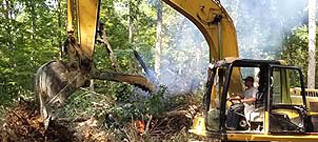Eastern Tent Caterpillars at Annoying Levels this Year
ANNAPOLIS, Md. - One of the most visible signs of spring this year is the abundance of Eastern tent caterpillar (ETC) nests. This native insect gets its name from its familiar silken tents in roadside trees. Typically there are only one or two tents per tree; however, many trees this year are sporting multiple tents, causing residents to be concerned for the trees as the caterpillars eat all the leaves.
"Residents are noticing the nests and may experience an annoyingly large population of caterpillars in their yards in the next couple of weeks," said Agriculture Secretary Roger Richardson. "While the Eastern tent caterpillar does eat the early leaves of trees and shrubs, the defoliation usually does little damage to trees, and rarely do trees die from an infestation."
The lack of damage is due to the timing not the severity of the defoliation. Because the caterpillars hatch as soon as the young leaves unfurl in the spring, the tree has put little energy into the leaves and typically re-foliate in June, seemingly no worse for wear. The young caterpillars venture out to feed on leaves during the night and return to the tents for protection during the day. They will feed on most kinds of fruit trees, many hardwood trees such as ash, maple and oak, and other plants in the rose family, like ornamental crabapples and plums, and even pyracantha. Curiously, ornamental flowering cherry and pear ("callery pears") both exotics, are left alone.
Homeowners concerned about particular plants may wish to keep an eye on them and consider EPA-approved insecticides before the caterpillars mature and are done feeding. The ETC finishes eating in mid- to late-May and leaves the tent to seek a place to spin a cocoon. By this time in the lifecycle, it is too late to use insecticides to control the fully grown tent caterpillars since most insecticides available to the public must be sprayed on leaves and ingested by the caterpillars to be effective. Mature caterpillars can easily be recognized by the solid white line down the middle of their back, and a pattern of blue markings on the sides. Later in the summer after laying eggs, the tent caterpillar emerges as a moth.
The Eastern tent caterpillar contrasts with the gypsy moths which finish consuming the leaves of oaks in early to mid June, after the leaves are fully developed. When heavy gypsy moth defoliation occurs, the trees are using depleted stores of energy to try to regenerate leaves and are vulnerable to other stress factors such as other insects and diseases, often leading to death of the trees. This is why the Maryland Department of Agriculture has had a gypsy moth suppression program for 25 years to control this exotic insect. Eastern tent caterpillars, on the other hand, are native to North America, do little damage to the trees, and their populations are eventually controlled by native predators, parasites and diseases and so there has been no statewide control program for eastern tent caterpillars.
For additional information, visit http://www.mda.state.md.us/go/tent.php.
Source: Md. Dept. of Agriculture


